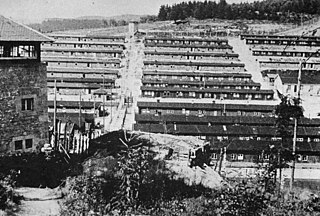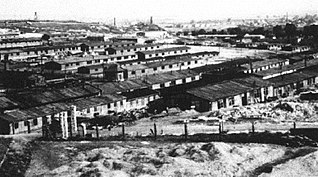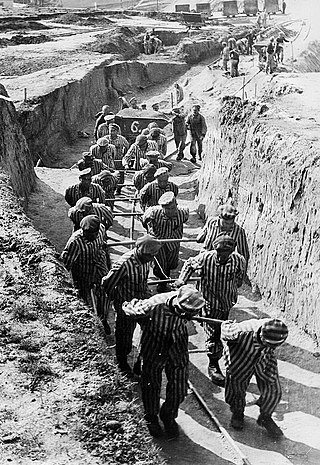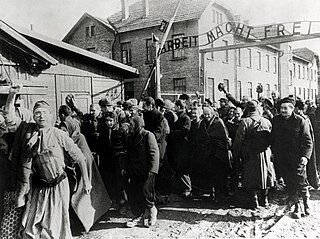
Flossenbürg was a Nazi concentration camp built in May 1938 by the SS Main Economic and Administrative Office. Unlike other concentration camps, it was located in a remote area, in the Fichtel Mountains of Bavaria, adjacent to the town of Flossenbürg and near the German border with Czechoslovakia. The camp's initial purpose was to exploit the forced labor of prisoners for the production of granite for Nazi architecture. In 1943, the bulk of prisoners switched to producing Messerschmitt Bf 109 fighter planes and other armaments for Germany's war effort. Although originally intended for "criminal" and "asocial" prisoners, after Germany's invasion of the Soviet Union, the camp's numbers swelled with political prisoners from outside Germany. It also developed an extensive subcamp system that eventually outgrew the main camp.

Mauthausen was a Nazi concentration camp on a hill above the market town of Mauthausen, Upper Austria. It was the main camp of a group with nearly 100 further subcamps located throughout Austria and southern Germany. The three Gusen concentration camps in and around the village of St. Georgen/Gusen, just a few kilometres from Mauthausen, held a significant proportion of prisoners within the camp complex, at times exceeding the number of prisoners at the Mauthausen main camp.

Aufseherin was the position title for a female guard in Nazi concentration camps. Of the 50,000 guards who served in the concentration camps, training records indicate that approximately 3,500 were women. In 1942, the first female guards arrived at Auschwitz and Majdanek from Ravensbrück. The year after, the Nazis began conscripting women because of a shortage of male guards. In the context of these camps, the German position title of Aufseherin translates to (female) "overseer" or "attendant". Later female guards were dispersed to Bolzano (1944–1945), Kaiserwald-Riga (1943–44), Mauthausen, Stutthof (1942–1945), Vaivara (1943–1944), Vught (1943–1944), and at Nazi concentration camps, subcamps, work camps, detention camps and other posts.

The German camps in occupied Poland during World War II were built by the Nazis between 1939 and 1945 throughout the territory of the Polish Republic, both in the areas annexed in 1939, and in the General Government formed by Nazi Germany in the central part of the country (see map). After the 1941 German attack on the Soviet Union, a much greater system of camps was established, including the world's only industrial extermination camps constructed specifically to carry out the "Final Solution to the Jewish Question".

From 1933 to 1945, Nazi Germany operated more than a thousand concentration camps, including subcamps on its own territory and in parts of German-occupied Europe.

Heinrich Schwarz was an SS-Hauptsturmführer (captain) and concentration camp officer who served as commandant of Auschwitz III-Monowitz in Nazi-occupied Poland and Natzweiler-Struthof in Alsace-Lorraine.

Monowitz was a Nazi concentration camp and labor camp (Arbeitslager) run by Nazi Germany in occupied Poland from 1942–1945, during World War II and the Holocaust. For most of its existence, Monowitz was a subcamp of the Auschwitz concentration camp; from November 1943 it and other Nazi subcamps in the area were jointly known as "Auschwitz III-subcamps". In November 1944 the Germans renamed it Monowitz concentration camp, after the village of Monowice where it was built, in the annexed portion of Poland. SS Hauptsturmführer (Captain) Heinrich Schwarz was commandant from November 1943 to January 1945.
The Fürstengrube subcamp was organized in the summer of 1943 at the Fürstengrube hard coal mine in the town of Wesoła (Wessolla) near Myslowice (Myslowitz), approximately 30 kilometers (19 mi) from Auschwitz concentration camp. The mine, which IG Farbenindustrie AG acquired in February 1941, was to supply hard coal for the IG Farben factory being built in Auschwitz. Besides the old Fürstengrube mine, called the Altanlage, a new mine (Fürstengrube-Neuanlage) had been designed and construction had begun; it was to provide for greater coal output in the future. Coal production at the new mine was anticipated to start in late 1943, so construction was treated as very urgent; however, that plan proved to be unfeasible.

Wilhelm Brasse was a Polish professional photographer and a prisoner in Auschwitz during World War II. He became known as the "famous photographer of Auschwitz concentration camp." His life and work were the subject of the 2005 Polish television documentary film The Portraitist (Portrecista), which first aired in the Proud to Present series on the Polish TVP1 on 1 January 2006.

During the Holocaust, death marches were massive forced transfers of prisoners from one Nazi camp to other locations, which involved walking long distances resulting in numerous deaths of weakened people. Most death marches took place toward the end of World War II, mostly after the summer/autumn of 1944. Hundreds of thousands of prisoners, mostly Jews, from Nazi camps near the Eastern Front were moved to camps inside Germany away from the Allied forces. Their purpose was to continue the use of prisoners' slave labour, to remove evidence of crimes against humanity, and to keep the prisoners to bargain with the Allies.

Subcamps, officially Arbeitslager der Waffen-SS, were outlying detention centres (Haftstätten) that came under the command of a main concentration camp run by the SS in Nazi Germany and German-occupied Europe. The Nazis distinguished between the main camps and the subcamps subordinated to them. Survival conditions in the subcamps were, in many cases, poorer for the prisoners than those in the main camps.
Paul Heinrich Theodor Müller was a German member of the SS and Concentration Camp Operational Leader (Schutzhaftlagerführer) at Auschwitz concentration camp.

Leitmeritz was the largest subcamp of the Flossenbürg concentration camp, operated by Nazi Germany in Leitmeritz, Reichsgau Sudetenland. Established on 24 March 1944 as part of an effort to disperse and increase war production, its prisoners were forced to work in the caverns Richard I and II, producing Maybach HL230 tank engines for Auto Union and preparing the second site for intended production of tungsten and molybdenum wire and sheet metal by Osram. Of the 18,000 prisoners who passed through the camp, about 4,500 died due to disease, malnutrition, and accidents caused by the disregard for safety by the SS staff who administered the camp. In the last weeks of the war, the camp became a hub for death marches. The camp operated until 8 May 1945, when it was dissolved by the German surrender.

Gusen was a subcamp of Mauthausen concentration camp operated by the SS between the villages of Sankt Georgen an der Gusen and Langestein in the Reichsgau Ostmark. Primarily populated by Polish prisoners, there were also large numbers of Spanish Republicans, Soviet citizens, and Italians. Initially, prisoners worked in nearby quarries, producing granite which was sold by the SS company DEST.

On 27 January 1945, Auschwitz concentration camp—a Nazi concentration camp and extermination camp in occupied Poland where more than a million people were murdered as part of the Nazis' "Final Solution" to the Jewish question—was liberated by the Soviet Red Army during the Vistula–Oder Offensive. Although most of the prisoners had been forced onto a death march, about 7,000 had been left behind. The Soviet soldiers attempted to help the survivors and were shocked at the scale of Nazi crimes. The date is recognized as International Holocaust Remembrance Day.

Blechhammer was the second-largest subcamp of Auschwitz concentration camp, part of the Blechhammer industrial area where several camps were located. The camp was evacuated on 21 January 1945; five days later, German forces returned to kill some survivors who had been left behind.

The Regensburg satellite camp, also known as the Colosseum subcamp in the vernacular at the time, was established in 1945 as the last subcamp of the Flossenbürg concentration camp in the Regensburg inn the Kolosseum. The Regensburg subcamp was in operation from March 19, 1945, until April 23, 1945. The Colosseum building is located at Stadtamhof 5, approximately 200 meters north of the Danube across the Stone Bridge from the Altstadt.















